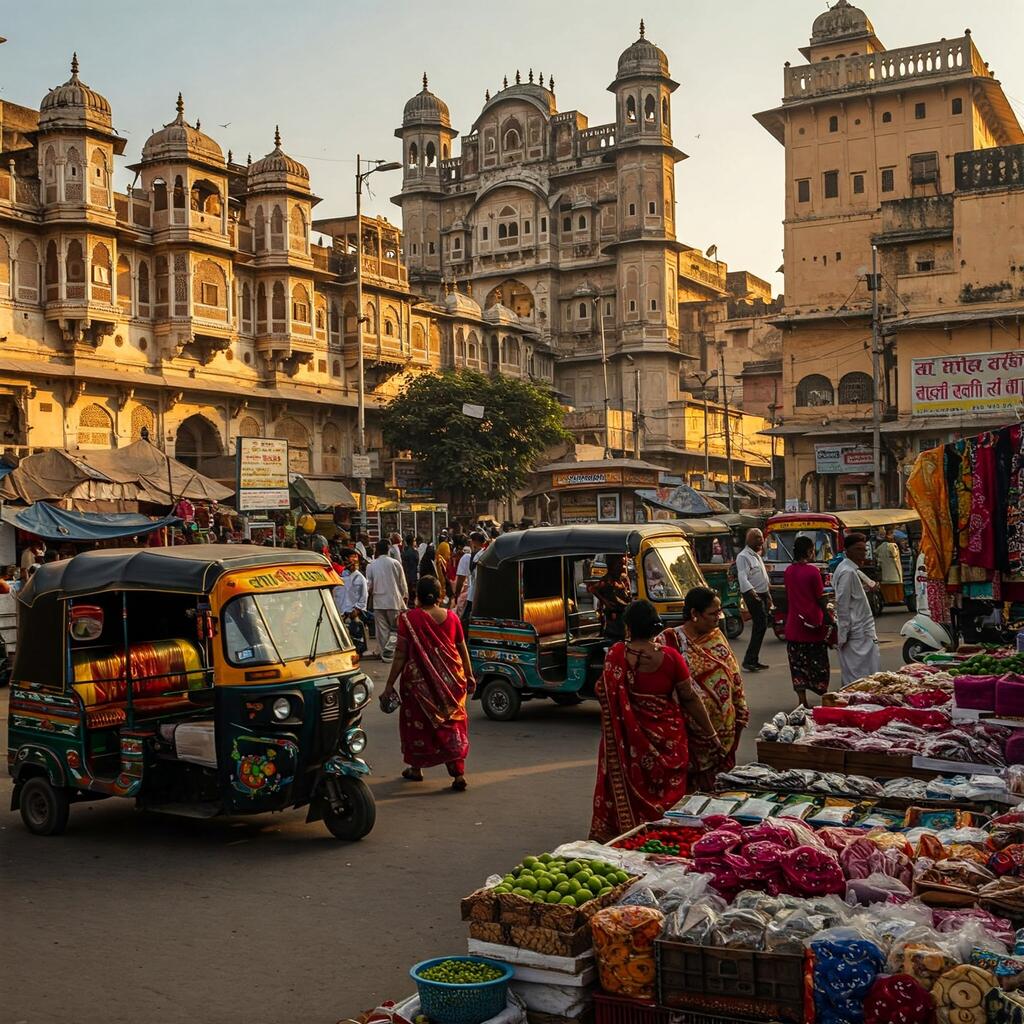
My Journey to India: Part 1 - First Impressions
My trip to India was special, and I'll tell you why later on. I did it before the year 2000, so most probably the India I saw no longer exists, as that country has had a huge economic boom in recent years.
I want to tell it as I experienced it then, because it was light years away from our Italy in many ways, and in a certain sense you found yourself catapulted back in time. The first was a big one, 17, the twins only 7, and for this reason I had a lot of doubts both before leaving and during the trip.
Before leaving in fact they made us do a prophylaxis for malaria and various vaccines, so I immediately imagined those places as dangerous for our health and that's why with two relatively small children I didn't enjoy my stay enough. Basically there was always that fear that I had exposed my children to danger. Good thing nothing happened afterwards.
The special part of this trip is that we didn't do it with some agency, but we were invited by an Indian family who lived half the year in Italy and half in India, specifically in New Delhi, and so we lived there for about twenty days, as long as the trip lasted, seeing up close the daily life they lived then and seeing things that on an organised trip we would never have seen.
We set off on ajourney that lasted almost a day, between Florence airport, Paris and then on to New Delhi.Paris-New Delhi alone took 11 hours, so we arrived in India late at night because of the time difference.We were picked up at the airport by our friend who took us to his house.
This person lives in a good neighbourhood of the capital, so I saw the beautiful villas in the neighbourhood. A little strange because they were all high and didn't have much of a garden around them, unlike the central part of the neighbourhood which was a real park, very nice and well-kept.
The house is very nice, there was a whole flat for our family. We could only sleep a couple of hours because at one point we were woken up by a very loud dirge coming from a loudspeaker. It was only 6 o'clock in the morning.
I looked out onto the terrace and saw a procession of people led by a very old man with a turban singing something with a megaphone. I was told that it is the yoga teacher calling his pupils who then all gather in the central park to do yoga. And this also happens in the evening around 5 p.m. And apart from that, always looking out from the terrace,
I see the terrace of the neighbouring house and a little man sitting on the ground among the buckets and cloths, he is doing the laundry. Each house has an area set aside for this. When he has finished, he hangs out the clothes on the terrace to dry and in the afternoon a woman comes by and picks up the clothes, irons them and puts them away in the various drawers and cupboards.
The washing machine does not exist.I understood when I heard this, how it is that our host family, especially the lady, changes clothes at least three times a day. But I would not change my life for hers. In fact she told me that she much prefers living in Italy because here she can work, go out shopping, and do many other things that a woman is not allowed to do in India.
I explain a little how a woman from that society, from a fairly rich caste, lives. In the morning, as soon as she gets up, she either does yoga or prays to the God of the day, because in India they have a different God every day. And each house, indeed each person in the house has his or her own personal God and different customs regarding especially food.
It is not uncommon in a family for the husband to have a different God than the wife and perhaps on Tuesday he cannot eat meat, while the wife cannot eat it on Friday. Or the fasting day is different. Strange things in short.Back to the woman, the day goes on with some visits, or hairdressing or television.
She doesn't go shopping, she doesn't do chores, she doesn't cook. For this there are servants, in our case a family of four who live in the basement of the house. And these are lucky because many other servants live just outside the walls of the neighbourhood.
I have seen that neighbourhood, and it is an open sewer with dilapidated shacks and a lot of filth, a very sad thing indeed.The Indian woman from a rich caste is mortally bored. Even going out alone is not allowed, but she has to do so only with her husband. She can only move around within the neighbourhood to visit her friends or relatives if they reside there.
What struck me about this life is the absolute lack of stress, that is, when you wake up you get up, when you are hungry you eat, and to work (these friends bought precious stones and sold them in Italy) you go when you feel like it. Maybe when the children go to school it will be different, but during the period in India the schools were closed for the summer holidays.
As I said, the house that housed us was very nice, from our flat we had two terraces, one opposite the other. There were no air conditioners as we understand them now, but the air in the small flat was freshened up at night before going to bed with ice water put in front of a fan.
Not much but it did something. However, we had to keep everything open because it was really hot and there were a lot of mosquitoes. We organised ourselves with cookers and smeared ourselves with suitable creams, but they were still biting. Good thing that on the ceiling of the room, which fortunately was very high, there were about ten geckos feasting on the mosquitoes.
The first night I had a lot of difficulty falling asleep with those geckos above my head, but then they assured me that they did not fall from the ceiling and ate a lot of mosquitoes so it was good that they were there. We as classic Italians took us to India, spaghetti and coffee and luckily our friends accustomed to Italian cuisine made us taste typical Indian recipes but we also had spaghetti with tomato sauce every day.
There was only chicken meat, but it wasn't much. In fact, most Indians are vegetarians and do not eat meat. So we ate flatbreads that were freshly prepared with very spicy gravies, rice in many ways, always with vegetables.
So the cooking didn't seem so great, in fact we all went home a bit thinner. In the morning, for example, for breakfast we drank a glass of a certain red liquid that I didn't like and neither did my children. We found some cereal bars and some small chocolates at the market and had breakfast with milk.
After breakfast we would go out to visit some tourist spots in the capital and our host would accompany us in a fairly large minibus where 9 of us were staying. You leave the walls of the neighbourhood where there is almost absolute silence and you enter streets that are busy not only with cars, trucks, trams, but also with camels, elephants and lots of cows roaming the streets. So it's all honking, all the time.
You go slowly, there are too many people to dodge, there are so many rickshaws and bicycles, but it is the animals that slow everything down. Cows, as I think you know, are sacred animals in India and they roam the streets quietly. No one moves them, everyone waits for the animal to move, and when it does, everyone rushes around playing as loud as they can.It's really chaos but a lot of fun, at every corner you find something strange, an elephant, a row of camels, a bus with people even climbing on it.
In New Delhi there are many places for a tourist to visit. Starting with the Red Fort. It is majestic and imposing with its walls of a distinctive red colour due to the sandstone from which it was built. Inside its walls there are many pavilions one more beautiful than the other, pools and huge halls with walls and ceilings inlaid with precious stones.
It takes several hours to visit the whole fort but it is well worth it. And inside there is also a large garden cut into two channels of water that come together in a pool. But any description I can give of it is always reductive, it must be seen in person.
Another thing to see in New Delhi is the market. It is a picturesque and very large place, winding through tiny streets where a myriad of little shops line its streets and alleys. There are some shops that are so small and low that the shopkeeper has to sit down to serve people.
But by sitting down, he does not have to lean far to reach all parts of his shop. It is also a colourful world of women's saris (the traditional dress of low-caste Indian women) while the richer caste women wear a foot-length tunic with very loose trousers underneath and a scarf over their shoulders. But all the dresses have incredible colours, they are very fine, almost impalpable.
The Indian sari, on the other hand, consists of a foot-length skirt, a bodice that usually leaves the belly uncovered and a very wide scarf draped over one shoulder. But the hustle and bustle, the calls of the shopkeepers, the colours, the often spicy smells transport you to a world almost out of a thousand and one nights.
And then the bazaars in the city centre, those full of lights and wonderful carpets, of colourful clothes, where you are offered tea and sit on soft cushions while the shop assistants show you what you want. Shopping then also turns out to be a truly relaxing activity.
In the Indian capital, which is truly immense, there are however many other places worth visiting, for example Indira Ghandi's tomb, which is located in the middle of a very large and well-kept garden where you walk barefoot and a soft grass carpet covers you.
In fact, another Indian custom is that in sacred places, like tombs, temples, you cannot enter with your shoes but you have to leave them outside. The strange thing is that we visited several places of worship and our shoes were always found.
To know what to see again in the Indian capital you just have to read some travel guides, but all the surroundings, the humanity, the life, the very different culture, the only thing is to see it live, to explain and tell about it is difficult, it is skin sensations that make me remember that trip with pleasure.
But my trip to India is not over here, in the next article I will tell about the trip to Jaipur, a trip full of emotions, in the ancient land of the Maharajas.






















